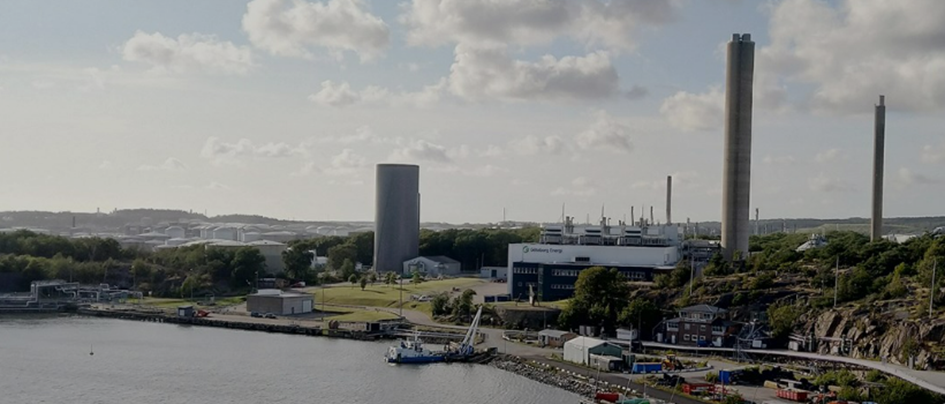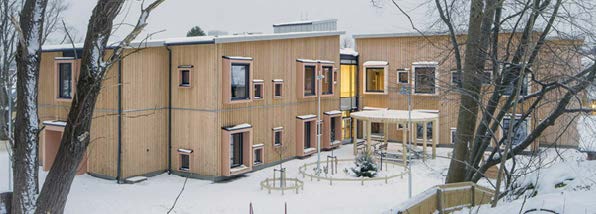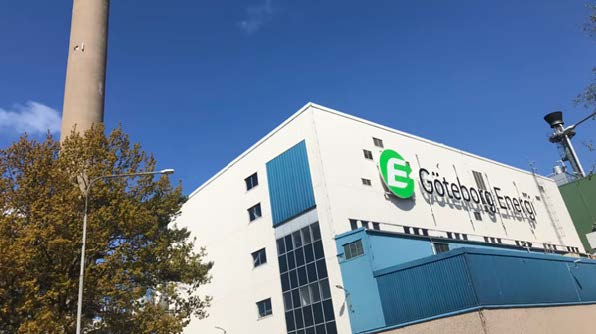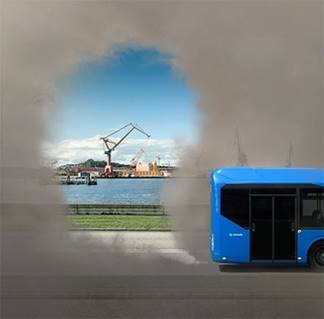Investment projects
Projects we have funded through Green Bond program will be listed here.
Project 2022
Göteborg Energi builds Gothenburg’s largest thermos
The 60-meter tall accumulator tank stands at the mouth of the Göta River, where it flows into the Kattegat. The accumulator tank operates as a thermal storage unit. When the demand for district heating is lower, heat (up to 1000 MWh) is stored in the tank. This stored heat can subsequently be utilized when demand increases. Once the tank is discharged, it can typically deliver 130 MW (up to a maximum of 200 MW) of heat for approximately seven hours. In this manner, peak loads in district heating production can be reduced, effectively decreasing the reliance on fossil fuel-based facilities.
Investment in district cooling facilities, Göteborg Energi
Göteborg Energi’s district cooling technology is built upon the same foundational principle as its district heating counterpart. The company’s district heating system serves as an expansive 1230-kilometer circulatory network, primarily powered by recycled or renewable energy sources. Key facilities, including Sävenäs WTE CHP, Rya CHP, and Rosenlund CHP, circulate heated water through an extensive underground piping infrastructure, supplying heat to 90% of multi-dwelling buildings, 10,000 villas, various industries, offices, retail establishments and other public structures.
District cooling production at Göteborg Energi relies predominantly on the utilization of recycled energy and the city’s abundant surplus heat, which is repurposed to generate cooling. The system also capitalizes on the cooling capacity of the Göta älv river for a significant portion of the year. While electricity does contribute to the district cooling process, it is employed at a substantially lower volume compared to traditional cooling machinery. According to the environmental values published for delivered district cooling for the year 2022, the source of supplied energy for district cooling is as follows: 85% of the energy came from recovered energy, where all of it was generated from industrial waste heat (e.g., from refineries). The remaining 15% came from renewable energy sources.
Consequently, Göteborg Energi’s district cooling presents a resource-efficient, comprehensive solution for indoor climate management, delivering quiet operation and virtually maintenance-free performance.

Flue gas treatment, Renova Miljö
The Sävenäs waste-to-energy plant is responsible for incinerating a majority of the combustible waste. The heat energy released through the combustion is recovered by converting it to district heating and electricity. For instance, one kilogram of energy-recycled waste provides hot water for a sevenminute shower and electricity for approximately three hours of computer use. The facility accounts for about 30 % of Gothenburg’s district heating and about 5% of Gothenburg’s electricity needs.
However, environmental quality standards in Gothenburg impose requirements that include restrictions on the amount of nitrogen oxide in the air. Although a significant amount of emissions come from maritime and road traffic, the Sävenäs waste-to-energy plant is also a significant point source for nitrogen and nitrogen oxide emissions. One of the main purposes of the investment in this project is to implement a cost-effective modernization of the flue gas treatment on line 1 at the Sävenäs plant. This modernization will reduce, among other things, nitrogen emissions into the air and water in such a way that the combustion capacity and availability can be maintained while the modernization is carried out.
Facility for recovery of zinc, Renova Miljö
The ash washing facility with zinc recovery, one of the first of its kind in the world, started as an extensive laboratory experiment with promising results. Subsequently, a pilot facility was built to test the method on a larger scale, and the results showed significant potential, with approximately 70% of all zinc being recoverable. In 2019, Renova’s board decided to construct a full-scale facility where 10,000 tons of ash per year will be managed. In brief, the process is as follows: The fly ash, i.e. the ash that accompanies the flue gas from waste incineration is washed out with hydrochloric acid, transferring the zinc to the liquid. The ash is then separated. After that, lye is added to the liquid for the zinc to precipitate and form flocks. Finally, when the liquid is pressed out a solid zinc product is obtained that can be returned to society. The washed ash is then burned again to become slag which after refinement may be used as construction material.

Project 2021
Wetland at Torsviken
The Port of Gothenburg in collaboration with the Swedish Transport Administration has completed a construction of a wetland for wildfowl at Torsviken. The wetland is a way of reinstating an area that has been used as a deposition site for dredging spoils for almost 40 years.
Ever since the seventies, the Port of Gothenburg has had permission to lay contaminated dredged material in Torsviken near the port at Hisingen. The masses have mainly been laid in an embanked area in the southern part of the bay.
In 2009, this permit expired. Since then, the Port of Gothenburg has worked to cover the masses and, as far as possible, restore the area’s original character with a rich natural and bird life. Before the wetland could be built, reinforcement work had to be done and the dredging site was covered with a clean material. During the construction of the new Marieholm tunnel in Gothenburg, large amounts of clay were excavated. This glacial clay was used to cover contaminated soil and thus create a protective barrier. This phase was completed in mid-2019 and since then the work of excavating and installing inlets and outlet system has continued. During 2021 the work of inlet of water from Torslandaviken to the new basin was completed and the basin was filled with water.

Björlanda pumpkedja
A zoning plan gained legal force in January 2020 to enable further development of northeastern Hisingen. However, to enable further exploitation of the area, it was proposed that three new pump stations should be built, starting from the current existing construction area, Skra Bro, and on to a connection point in central Hisingen, via an intermediate station that replaces the existing station at Östergärde industrial area. The motive for the project is due to the fact that the possibility of diverting wastewater from the area around Skra Bro is limited. In order for new properties to be able to be connected without the risk of basement floods or increased discharge of wastewater to Osbäcken, capacity-increasing measures are required. In connection with this, the security of supply of drinking water is also strengthened.
Hoppet - Sweden’s first fossil-free construction project
As a first step to minimize the climate impact from construction processes, an innovative project to build a fossil-free preschool called ’Hoppet’ was started. The ambitious task aimed at a preschool constructed as far as possible with fossil-free material and procedures. From resource extraction to construction site and operation. In addition to the goal of minimizing the climate impact in this project, the aim is also to push and stimulate the industry to develop new fossil-free materials, methods and processes.
For instance, an important reason why the climate impact is greatly in the construction of ’Hoppet’ is that the preschool is built from wood and that it has a solution that replaces the traditional concrete foundation. Concrete is a well-proven method; however, it accounts for a relatively large part of the climate impact in a construction project. In this project foamglas is used instead, where the insulation consists of 60-70 percent recycled glass and weighs much less. According to measurements made for this project, the climate impact was reduced by 70 percent for main building components compared with a newly built and comparable preschool in Gothenburg.

500 new public charging stations for electric cars
The investment in public charging for electric cars is one of Göteborg Energi’s many efforts for a sustainable Gothenburg. The project is a collaboration between Göteborg Energi and Göteborgs Stads Parkering and have resulted in 500 new charging stations available around the city. The chargers are located in public parking areas where there were no chargers, and in existing parking spaces with high occupancy. Primarily, the chargers are located in the central parts of the City where there is a high demand from both residents and visitors.
Göteborg Energi invests in a new biofuel-boiler
An important step towards Göteborg Energi’s goal of 100 percent recycled and renewable sources in district heating in year 2025 was taken when a decision was made to invest 500 MSEK in a new bio-fuel boiler at Rya Hot Water Center. The two previous boilers were originally designed for oil and coal but converted to run on wood pellets in 2003. However, they reached their technical service life and have been replaced by a new and modern boiler. The new boiler, which is designed for pellets, will deliver improved combustion, higher efficiency and generate more heat than the previous boilers. Installed capacity in the plant will increase from the current 100 MW to 130 MW.

Project 2019
Electrical buses
30 electrical buses owned by Göteborgs Spårvägar are now in use on the streets of Gothenburg. The buses are charged with green electricity and has a battery capacity of 200 kWh. Modell name is 7900e and was built by Volvo Buses. The operator Västtrafik has the ambition that all public transports in the city shall be electrified before the year 2030.

Hotel
The amusement park Liseberg has decided to build Grand Curiosa Hotel, and the aim is to reach the building standard BREEAM-SE Excellent. Budgeted cost is 1.179 MSEK.
The project will contribute to Liseberg's goal of 100 percent climate-neutral operations, primarily in the form of energy-efficient buildings with climate-neutral energy sources, but also by systematically choosing building materials with low CO2 emissions from a life cycle perspective.

Project 2018
GöteborgsLokaler – sustainable building
Selma Town hall
Selma Town hall, is a 5,500 square meter, four-story building housing a community service, library and leisure center, in addition to activities for senior citizens, a cultural school, a restaurant and daily activities.
The vision is to be a welcoming and social environment full of life. The mixture of different amenities promotes a creative environment with opportunities for interesting and inspiring meetings between people with different backgrounds. The facades of the house are designed as large curtains where small and larger openings expose the activities inside.
The building is silver-certified by Sweden Green building Council, which means an energy consumption less than or equal to 75% of the Swedish building code and a energy for heating requirement of 40 kWh/sqm or less. Regarding energy sources, there is also a requirement that at least 10% must come from renewable energy (environmental category 1) and less than 25% from non-renewable sources (environmental category 4). In addition to energy requirements, Sweden Green building Council also implements high indoor environmental (noise environment; air quality; daylight; moisture; thermal climate and legionella) and building material (removal of dangerous substances; documentation of building materials) requirements.
Göteborgs Energi – investment in renewable energy
Nya Solevi-Sweden´s largest solar park

Photo: Paul Olsson
Sweden´s largest solar park ‘Nya Solevi’ has been built by Göteborg Energi at Säve airport. Nya Solevi covers an area of 11 hectares, equal to the size of 16 football fields combined.
The facility comprises 20,000 panels with an expected lifespan of 30 years, which will produce about 5.5 GWh of electricity every year. This is sufficient to power 1,100 private houses.
Göteborg Energi announced a competition to determine the name for the park. The winning contribution, Nya Solevi, has a local connection. The largest two football stadiums in Gothenburg are named ‘Gamla (old) Ullevi’ and ‘Nya (new) Ullevi’. In addition, the name implies renewable solar energy.
Project 2017
Eco-cycle and water administration
Kodammarna- sewage pump station

Sketch
of pump station, Kodammarna
The purpose of the investment is to secure the operation of Kodammarna pump station and reduce the overflow to the river Göta älv. The pump station drains sewage from 160,000 people, and it is crucial that it is in continuous operation. The pump station will be more energy efficient and measures to adapt the station to higher water levels will be made. The roof is prepared for installation of solar panels. The work is expected to be completed in 2022.
Project 2014
Lokalförvaltningen – projects in sustainable housing
We build only low-energy when we build new buildings
A new building in Lokalförvaltningen auspices should only use a maximum of 45 kWh / year of energy for heating, hot water and building operations. This is about 60% lower than required in the national building regulations and is in line with passive house standard. In addition, we make very high demands on the energy performance of the components that affect the company’s energy consumption, such as energy saving light with smart control, energy-efficient appliances.
We put very high standards on materials use
We assume that children are more sensitive to exposure to hazardous materials. Therefore, we avoid such endocrine disruptors. Durability over time is a key word. Several projects have green roofs, known as sedum roofs to increase biodiversity, add more green in the urban environment, reduce stormwater flows, creating better microclimate and promote noise reduction.
The energy efficient preschool ‘Krumeluren’

Photo: Lo Birgersson
‘Krumeluren’ is an energy efficient building with passive house standard. In addition, there are no plastic carpets with hormone-altering plasticizers and no material with high emissions. The building also has green roof to add more green in the urban environment, reduce storm water flows, create better microclimate and promote noise reduction.
Göteborg Energi AB – investments in district heating
Celsius – district heating for boats
In Celsius, the city has a “lead” position and Göteborg Energi AB project manages the various European cities participating in the project. Purpose is to show how the district heating and cooling can be used in particular to utilize waste heat in a city and maximize energy efficiency. EU demands this kind of solutions to achieve the 20 percent energy efficiency by 2020.
A measure implemented by Celsius project is to heat a large ferry with district heating when it is docked. Göteborg Energi’s district heating system supplies the Stena Danica with hot water by a new heat exchanger. Gothenburg and Stena Line are the first in the world with this. Since earlier the ferry is also connected to the land electricity network. This saves emissions of 500 tons of carbon dioxide per year.
Celsius – district heating for domestic appliances
Instead of heating water in a washing machine or air in a dryer with electricity, a use can be made of district heating. Using district heating, it is possible to replace up to 80% of electricity demand and reduce the power requirement of electricity by up to 90%. With disting heating, the heat comes from the heat exchanger to the machines, instead from of electricity.
Gryaab – Denitrification
In order to fulfill Sweden’s commitments under the Baltic Sea Action Plan and to meet future population growths, Gryaab estimates that it is necessary to increase nitrogen retention further. Gryaab has decided to invest SEK 360 million on an expansion of existing denitrification facilities. The new plant if expected to be taken into use in 2016. The nutrient nitrogen is of great importance for the eutrophication of the North Sea.
Gryaab nitrogen removal is done in two steps. In the first step transforms bacteria ammonium into nitrate and in the other nitrate to nitrogen gas. The nitrogen then end up in the air rather than to fatten the sea. The new extension will increase capacity in the first stage.
A reactor with so-called mobile carriers will be built. The carriers are plastic pieces which bacteria adhere and grow into. The use of mobile carriers is an effective way to purify water in a small space. Prior to the decision, consultations with Gryaab seven owner municipalities were conducted. All municipalities were in favor of the investment.
Project 2013
Lackarebäck water treatment and purification filter management cycle and water
- The largest ultrafilter built in Scandinavia
- Water treatment by ultrafilter
- Ultra-Filter is an independent microbiological barrier, which means a good barrier effect even during disturbances
- Capacity Increase by 40%
- Ready to use 2015
- Total cost 700 million
Estimated effects of the project
- Capacity increase of 40%
- Socio-economic benefits in terms of lower disease outbreaks that saves up to 290,000 days of lost productivity from 2014 to 2038
- Socio-economic benefits in terms of cost savings of 1.4 million hospital Days
GoBiGas
- Large-scale production of biogas
- Effective – high efficiency in production and recycling of waste heat for district heating and electricity
- Flexible – can withstand varying quality of raw material
- Platform for development within industry and academia
Estimated effects of the project
When the plant is in full production, the delivery will amount up to 800-1000 GWh, equivalent to fuel for between 80,000 to 100,000 cars.
Electric cars
Gatubolaget has purchased a number of electric vehicles for city departments and companies. The goal was 100 electric vehicles in the city fleet by 2015.
Already Tuesday, December 10, 2013 delivered the 100th electric car to the health-care team in Angered.


